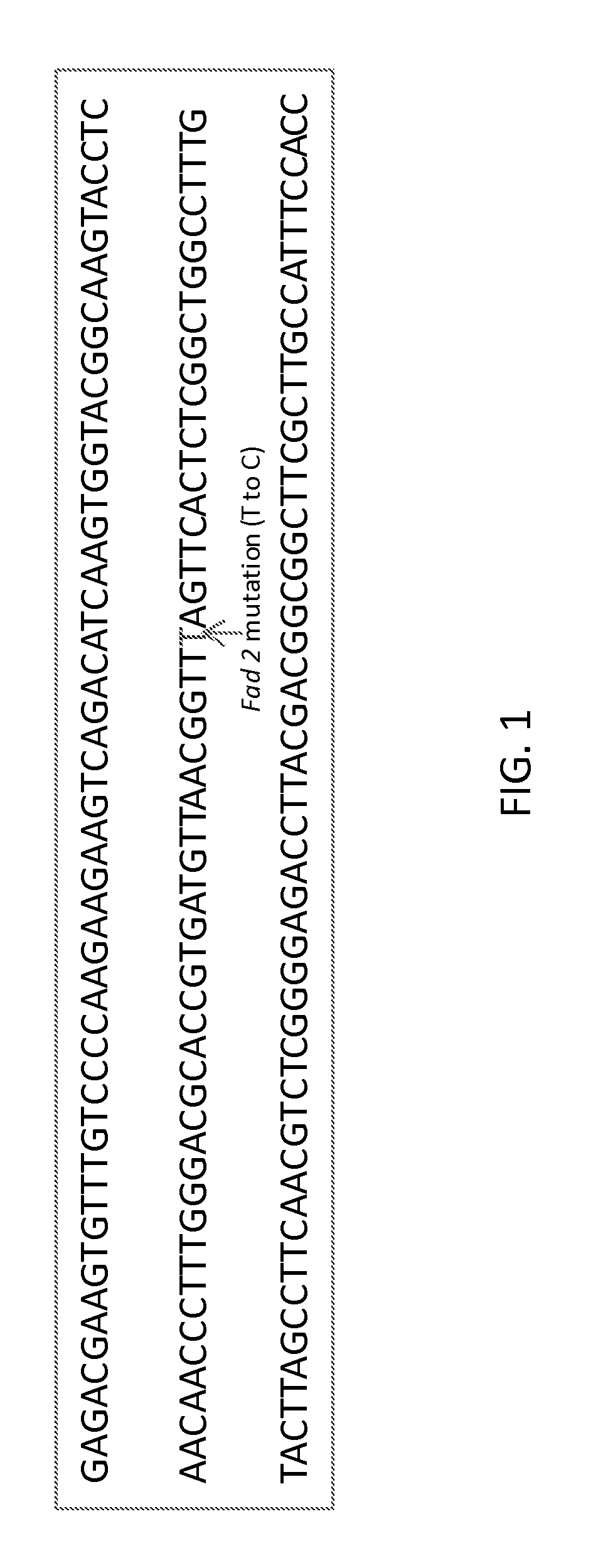Method to determine zygosity of the fad2 gene in canola using end-point taqman PCR
- Summary
- Abstract
- Description
- Claims
- Application Information
AI Technical Summary
Benefits of technology
Problems solved by technology
Method used
Image
Examples
example 1
[0097]An end-point TaqMan® assay was developed to detect the fad-2 SNP mutation and to determine zygosity status of canola plants containing the fad-2 gene mutation in breeding populations. Two primers were designed to bind highly conserved DNA sequences, located upstream and downstream of the fad-2 gene. These primers amplified a 91 bp DNA fragment which spanned across the fad-2 SNP in mutated and un-mutated canola plants. The fad-2 mutation in canola is described by Hu et al. (2006) and characterized as a SNP of cytosine (C) to thymine (T) located in the expression region of the fad-2 gene (FIG. 1). Two TaqMan® minor groove binding non-fluorescent quencher (MGBNFQ) probes were designed with FAM and VIC as reporter dyes to detect the presence of the wild type fad-2 gene and the mutated fad-2 gene (which consists of a SNP), respectively. These probes were designed to comprise increased specificity (e.g., have a greater affinity) for detection of the wild...
example 1.1
gDNA Isolation
[0098]Genomic DNA (gDNA) samples of 625 different canola plants containing the fad-2 SNP and control (wild type fad-2) canola plants were tested in this study. gDNA was extracted using modified Qiagen MagAttract plant DNA kit (Qiagen, Valencia, Calif.). Fresh canola leaf discs, 4 per sample, were used for gDNA extraction. The gDNA was quantified with the Pico Green method according to vendor's instructions (Molecular Probes, Eugene, Oreg.). Samples were diluted with DNase-free water resulting in a concentration of 5 ng / μL for the purpose of this study.
example 1.2
TaqMan® Assay and Results
[0099]Specific TaqMan® primers and probes were designed for use in a TaqMan® end point assay. These primers and probes were designed to amplify and detect the region of the fad-2 gene comprising the SNP of interest. These reagents can be used with the conditions listed below to detect the mutated fad-2 gene within canola plants. Table 1 lists the primer and probe sequences that were developed specifically for the detection of the fad-2 SNP in canola plants.
TABLE 1 Taqman PCR Primers and ProbesSEQ IDDescrip-NO:NametionSequenceSEQ IDD-CL-ForwardAGACGTTGAAGGCTAAGTACAAAGGNO: 2FAD2-FprimerSEQ IDD-CL-ReverseGGCAAGTACCTCAACAACCCTNO: 3FAD2-R2primerSEQ IDD-CL-Probe toVIC-ATGTTAACGGTTTAGTTCAC-NO: 4FAD2-detectMGBVICmutantSEQ IDD-CL-Probe to6FAM-TTAACGGTTCAGTTCAC-NO: 5FAD2-detectMGBFAMwildtypeSEQ IDD-CL-ReverseCAAGTACCTCAACAACCCTTTGGNO: 6FAD2-Rprimer#2
[0100]The PCR reaction mixtures for amplification are as follows: 1×TaqMan® GTExpress Master Mix, 0.9 μM forward primer ...
PUM
| Property | Measurement | Unit |
|---|---|---|
| Temperature | aaaaa | aaaaa |
| Temperature | aaaaa | aaaaa |
| Fluorescence | aaaaa | aaaaa |
Abstract
Description
Claims
Application Information
 Login to View More
Login to View More - R&D
- Intellectual Property
- Life Sciences
- Materials
- Tech Scout
- Unparalleled Data Quality
- Higher Quality Content
- 60% Fewer Hallucinations
Browse by: Latest US Patents, China's latest patents, Technical Efficacy Thesaurus, Application Domain, Technology Topic, Popular Technical Reports.
© 2025 PatSnap. All rights reserved.Legal|Privacy policy|Modern Slavery Act Transparency Statement|Sitemap|About US| Contact US: help@patsnap.com


